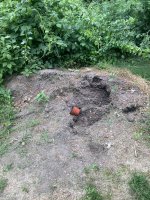Does 40 plus years veggie gardening qualify me to be a "gardening veteran"?

or alternately to be "nice and aged",

Regardless, here's my take part of which I mentioned earlier. I use extensive cover cropping year around, virtually no synthetic sources of fertilizer, and I till according to the needs of my soil which often can be several times a year or alternately maybe no disturbance for several months. All depends on the need.
I do not understand how anyone could make effective use of cover cropping as I do without tilling. No till makes no sense to me. If it's no cover vs no till guess which way I'm jumping?
For example, I definitely shred/till my alfalfa cover crops back into the soil when thy have completed their production cycles...same for summer covers like peas, soybeans, and Sunn Hemp which I'm currently experimenting with as possibly the highest nitrogen fixing agent available to the "veteran" gardener. Tilling is required to get a good seed bed for all my cover crops and also get a good seed bed for the garden veggies that always follow.
I honestly don't appreciate, perhaps its understand, the no tilling fad for home veggie gardeners.
Take a look at this alfalfa cover crop and tell me how you would best get that resource into the soil? How would you follow it up with corn, okra, tomatoes, etc. without tilling? Just makes no sense to me.
View attachment 91116



